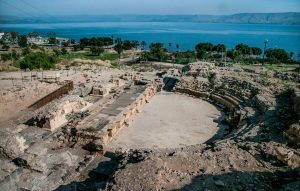I get by with a little help from my friends. That could be the message of the story on Sanhedrin daf 30:
“Rabbi Shimon ben Elyakim was striving to ordain Rabbi Yosei, son of Rabbi Ḥanina, and was not successful. One day, Rabbi Shimon ben Elyakim was sitting before Rabbi Yoḥanan. Rabbi Yoḥanan said to his students: Is there anyone who knows whether the halakha is in accordance with the opinion of Rabbi Yehoshua ben Korḥa, or not? Rabbi Shimon ben Elyakim said to him: This one, [Rabbi Yosei, son of Rabbi Ḥanina] knows. Rabbi Yoḥanan said to him: If so, let him say. Rabbi Shimon ben Elyakim said to him: Let the Master ordain him first; “(Sanhedrin 30b)
After Rabbi Yochanan acquiesces to Rabbi Shimon’s request, he hears Rabbi Yosei’s answer. It is not what he is looking for, but nevertheless he allows the ordination to stand because Rabbi Yosei is a “gavra rabba,” a great man. We hear this phrase attached to Rabbi Yosei in another instance:
“Rather, Rav Asi said: I heard this statement from a great man, and who is he? He is Rabbi Yosei, son of Rabbi Ḥanina.” (Bava Kamma 42b)
We also hear that he was a great judge:
“Wasn’t Rabbi Yosei bar Ḥanina a judge who delved into the complexities of the halakha?” (Bava Kamma 39a)
Who is Rabbi Yosei? Rabbi Yosei was an amora of the second generation (250 -290 CE) in the Land of Israel. He was a younger contemporary of the great Rabbi Yohanan, and is mentioned as quoting beraitot before him (Meila 16b). Rabbi Yosei’s generation was full of scholars, including Rabbi Yochanan’s sparring partner Resh Lakish, Rabbi Elazar ben Pedat and others. Rabbi Yochanan himself had many students and was a revered figure. Eventually Rabbi Yosei moves from being Rabbi Yochanan’s student to being his “talmid-chaver,” his equal, able to disagree with him, as we see in the story above (Bava Kamma 39a).

Ancient Tiberias, the center of Torah study in Rabbi Yochanan’s time
עמוס גל, CC BY-SA 4.0 <https://creativecommons.org/licenses/by-sa/4.0>, via Wikimedia Commons
Besides judging monetary and other cases, Rabbi Yosei was known as a darshan, someone who taught lessons from the Torah. He is quoted in Bereshit Rabba as emphasizing the importance of chastising people who do not behave correctly:
“Abraham reprimanded Avimelekh…” – Rabbi Yosei bar Ḥanina said: Reprimand leads to love, as it is stated: “Rebuke a wise person, and he will love you” (Proverbs 9:8). This is consistent with [another] opinion of Rabbi Yosei bar Ḥanina, as he said: Any love that is not accompanied by reprimand is not love.” (Bereshit Rabba 54:3)
Eventually Rabbi Yosei became so well-known that he became part of the Rabbinic pantheon. Sanhedrin 17b lists rabbis who are so ubiquitous that we don’t even need their names to know who they are. Rabbi Yosei is in this category, although there is a dispute over which title belongs to him:
“ ‘They sent a message from there’ [Eretz Yisrael], is referring to Rabbi Yosei bar Ḥanina; . . .’They laughed at it in the West,’ means Rabbi Yosei bar Ḥanina (Sanhedrin 17b)
Rabbi Yosei was not only prominent in the court and the bet midrash, he seems to have been very wealthy as well. Before the shemitta year he would instruct his servant to gather enough produce for the three years – before the shemitta, during and after (Bava Batra 90b). This required a serious cash flow. However, he was not as lucky in his personal life. From a laconic statement regarding mourning practices we hear that he lost more than one son, in quick succession:
“An incident occurred in which the sons of Rabbi Yosei, son of Rabbi Ḥanina, died, and he bathed in cold water all seven days of mourning. There it is referring to a case where his mourning periods came immediately one after the other,” (Taanit 13b)
Rabbi Yosei becames one of the Rabbinic figures most associated with the Torah of Eretz Yisrael. His final glory is when he appears to Rabbi Zeira in a dream and relates that his neighbor in Gan Eden is none other than Rabbi Yochanan!
“Rabbi Zeira said: Last night, Rabbi Yosei, son of Rabbi Ḥanina, appeared to me in a dream. I said to him: Near whom are you placed? He said to me: Near Rabbi Yoḥanan.” (Bava Metzia 85b)
The other protagonist in our story is Rabbi Shimon ben Elyakim (or ben Yakim as the Yerushalmi refers to him). We know less about him but it seems that he also was a judge, alongside Rabbi Elazar ben Pedat:
“Go to Rabbi Shimon ben Elyakim and Rabbi Elazar ben Pedat, who rule that there is liability for damage caused by indirect action” (Bava Kamma 117b)
All the accolades that Rabbi Yosei receives raise the question of why he would need Rabbi Shimon’s help in the first place? Wouldn’t Rabbi Yochanan have noticed his greatness on his own and ordained him? The Yerushalmi’s version of the story makes us question our version even further:
“Rebbi Yochanan was sitting and asking, maybe somebody is here who heard that practice follows Rebbi Nathan? Rebbi Yosei bar Ḥanina told him, that is Rebbi Simeon ben Yakim. He said, may he come up. . . He said, Rebbi Yosei ben Ḥanina only intended to elevate Rebbi Simeon bar Yakim because he was an important person.” (Yerushalmi Sanhedrin 3:9)
Whose version is correct? Perhaps Rabbi Yosei, well-placed as one of Rabbi Yochanan’s best students, intervened to help Rabbi Shimon, who seems less well-known and perhaps less prestigious? Rabbi Aharon Heyman in his book about the Sages thinks that the Bavli version is the correct one, since Rabbi Shimon seems to be an established teacher earlier that Rabbi Yosei. But the two versions of the story do allow us to question who was the benefactor and who was the beneficiary.
No matter who helped who, the lesson is the same – if you have reached a higher rung on the ladder, extend your hand to your friend who has not gotten there yet.

Austin Kehmeier, Unsplash










